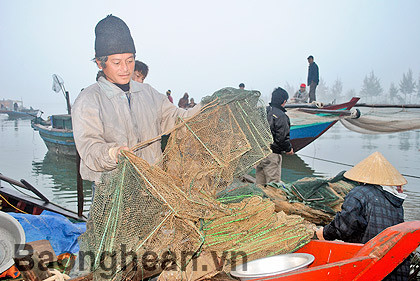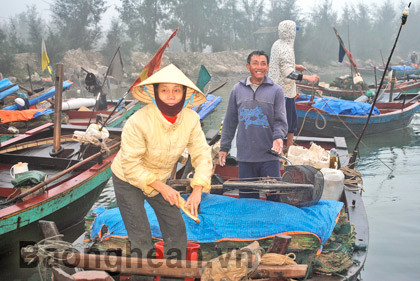Tan Lap coastal village is still "stranded"
Tan Lap 1 and Tan Lap 2 hamlets in Nghi Quang commune have long been considered the poorest coastal villages in Nghi Loc district. Fishermen still make a living by fishing, but because their boats are small and their engines are weak, they only fish close to shore. The money they earn from seafood is only enough to cover their daily meals and clothing...
(Baonghean) -Tan Lap 1 and Tan Lap 2 hamlets in Nghi Quang commune have long been considered the poorest coastal villages in Nghi Loc district. Fishermen still make a living by fishing, but because their boats are small and their engines are weak, they only fish close to shore. The money they earn from seafood is only enough to cover their daily meals and clothing...
At about 3 pm on a day in the middle of December of the lunar calendar, I arrived at Nghi Quang commune. Although the weather had warmed up after a series of long cold days, at that time, fog had spread throughout the village. On the mountain peaks jutting out to the sea, which the locals have long called Hai Tram mountain, Ru Con hill and Con Lon mountain, fog had covered everything in white. Mr. Tran Hai Duong - Chairman of the People's Committee of the commune said, the coastal area here is like that this season, on warm days, fog only comes from the sea at 3 pm, if it's cold, by 2 pm, the treetops in the village are already covered in fog. Nghi Quang commune has 7 hamlets, of which 2 hamlets: Tan Lap 1 and Tan Lap 2, all households have lived off the sea for generations, and until now the fishermen's lives are still very poor! The reason is that people try to maintain the profession of catching seafood near the shore. Currently, nearly 100% of households working at sea still use small boats with small engines, capacity under 20CV to catch shrimp, fish... near the shore. With little investment and petty business, the daily income is only a few hundred thousand dong. That amount of money only covers the whole family for the day. Moreover, people there have many children...

Mr. Nguyen Van Tam, after a night of fishing, lost and tore 5 fishing nets.
After the afternoon working hours, Mr. Duong took me to Tan Lap 1 and Tan Lap 2 hamlets. At this time, the hamlets gradually lost men, leaving only women and children. If anything, they were just men who specialized in trading goods for fishing, or a few households engaged in shrimp farming. Another thing I noticed was that in these two hamlets, the houses were close together, adjacent to each other, the village roads and alleys were mostly concreted, the road surface was only a few meters wide. Mr. Nguyen Xuan Hong - hamlet chief of Tan Lap 1 hamlet, said: At this time, the main labor force in the hamlet had gone to Lach Lo, preparing boats for a new sea trip, and they would return tomorrow morning. Fishermen here use small boats to catch seafood, so they only go at night. Because the boats are small, families are self-employed. Families with older sons go to sea with their fathers, if not, both husband and wife go together. It is common for women in Tan Lap to go to sea to fish. Near dusk, we followed the concrete road of the Nghi Quang irrigation project to Lach Lo. At this time, Lach Lo was quiet without a boat. Standing on the Nghi Quang road, looking towards the residents of Tan Lap 1 and Tan Lap 2 hamlets, many high-rise buildings were painted with new paint. Mr. Hong confided that those high-rise buildings were built with money sent from abroad. That means, up to now, several hundred children in these two hamlets have gone to work abroad in countries such as Taiwan, Korea... Thanks to that, many families have the conditions to build high-rise buildings, but if they stick to the sea like this, they are lucky to have enough to eat. Families who have been fishing for generations still live in level 4 houses, or semi-permanent, low, small houses. Tan Lap 2 hamlet has 226 households, 1,115 people, of which nearly 100% of the households work as fishermen at sea. Currently in the hamlet there are still 43 families classified as poor households according to State standards.
3 years ago, fishermen in Tan Lap 1 and Tan Lap 2 hamlets also had some families jointly invest in buying big boats, big machines to go out to sea to do light net fishing, squid fishing... Due to losses, they switched to nearshore fishing. In particular, in the past 3 years, fishermen here have been using monster nets (made in China) to catch seafood. Monster nets are fishing tools that fish close to the seabed, no matter what kind of fish, from small as a chopstick to large fish weighing 2-3 kg, can be caught. Therefore, fishermen here compete to buy monster nets to catch more seafood. After a trip to sea, fishermen bring back many different products: shrimp, crab, fish, squid... a little of each type, sold right at the wharf. In this season, the fog is thick, each night of fishing, a boat can only catch 10 kg of seafood of all kinds, sold for about 300-500 thousand VND, minus the cost of fuel, food... 200 thousand VND. That is an advantage, but if any boat is unlucky enough to encounter a big boat with a big engine that is engaged in crab polishing, or is caught in a trap with our monster net, then that trip is considered a loss. Our boat is small, the engine is small, seeing it pull our net and net, we are very angry, but we can only stand and watch. A monster net costs 350 thousand VND, there are families who lose ten in one night. Statistics show that these two poor hamlets currently have 130 boats using monster nets to catch seafood. The boat with the least number has 10 nets, the boat with the most number has up to 80. It turns out that after each night at sea, fishermen in these two hamlets catch about a few tons of seafood of all kinds. When the boat docks at Lach Lo, all the seafood is sold to the women in the hamlet, who bring it to the rural market.
At 6am the next morning, we returned to Lach Lo when the fog was covering the casuarina trees. From afar, small boats appeared, then gradually became clearer in the white mist. At Lach Lo wharf, many women were sitting waiting for their goods to arrive. Boats docked one by one, each boat had 2 people, either father or son or husband and wife. The seafood brought from the boat was not a ton or a bird's nest, but just a few bunches of shrimp, fish, and squid. The big bunches were 5kg, the small ones were a few kg. There were also many boats selling products from Cua Lo Port. Mr. Nguyen Xuan Hong (head of Tan Lap 2 hamlet) who was with me confided: "The boat with the most got 600,000 VND. There were also unlucky boats, with large local boats passing by, dragging away a number of nets, and considered a loss." Every time a boat docked, there was a fight to buy and sell seafood among the women in the hamlet. Ms. Ha, a resident of Tan Lap 1 hamlet, confided: There are so many boats, but very little product. Every morning, if we are lucky, we can only buy 10 kg of squid, 5 kg of shrimp and a little fish, bring them to the local market to sell, and earn a little profit. Women in the hamlet, those who follow their husbands to sea, do not have to, otherwise they can only buy and resell seafood to earn money to support their lives.

Tan Lap women follow their husbands to sea
The most disappointed person among the 130 boat owners that morning was probably Mr. Nguyen Van Tam, Tan Lap 2 hamlet, because last night, he lost 5 monster nets, just because some big fishing boats towed them away. His boat had 60 monster nets in total, last night he caught 600 thousand VND, after deducting expenses, he still had a profit of 400 thousand VND. But the lost nets were considered to have taken a whole week to save up enough money to buy them back. Nguyen Van Trang, Tan Lap 1 hamlet, shared: "This job is just enough to eat, but it cannot make you rich. Before, I joined some people to invest in buying a large offshore fishing boat, but because I had to support 6 people in the house, I could not afford it. About 5 years ago, I bought an 18CV boat and fishing gear, spending 70 million VND. Having my own boat, every night when the weather is favorable, my husband and I go to sea together. After a night, we always earn a few hundred thousand VND, enough to support 4 children's education. Because the boat is small and fishing close to shore, on stormy days, with winds of level 5 or higher, we do not dare to go." Speaking of this, I suddenly remembered the story told by the Chairman of the Commune People's Committee: In 1992, a sea tornado took the lives of 50 people in the commune. During the year, fishermen here have 4 consecutive months (from December to March of the following year) when their catch decreases significantly due to the effects of dense fog.
Mr. Hong, who specializes in trading fishing gear, said that almost every boat has its fishing gear stolen by trawlers every year. The most boats lost were 30, the least lost were 10. There are families in difficult circumstances who do not have the cash to buy fishing gear for tens of millions of dong at once. I also sell on credit and pay back gradually after each night at sea.
Fishermen here are like that, drifting at night at sea, coming home to rest during the day, hoping that the seafood they catch is just enough to cover their expenses for the day. As for getting rich, no one probably thinks about it. Therefore, poverty here has been the same for generations. Mr. Tran Hai Duong (Chairman of the Commune People's Committee) told me: "It is very difficult for fishermen here to change their fishing profession from nearshore to offshore. Because most of the households here are poor and near-poor, where can they get the money to invest billions of dong to buy big boats and big machines? If the State lends money, they will borrow several billion at a time, fishermen do not dare. In 1989, the State invested in Tan Lap Cooperative 3 boats (each boat 135 CV) for offshore fishing. After 3 years of operation, it was dissolved, then Sao Mai Company Limited was established, specializing in offshore fishing. After only a few years, it was also dissolved because of ineffective operations. From that reality, combined with the poverty of the people, in the commune today, there is no such thing as 5-7 families joining together to buy a big boat for offshore fishing, but most of them buy small boats for nearshore fishing. The question is, how long will Tan Lap be poor? And how can we eliminate the poorest coastal hamlet? district, still no answer!"
Article and photos: Xuan Hoang






